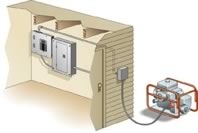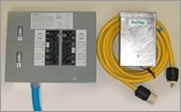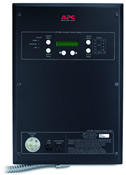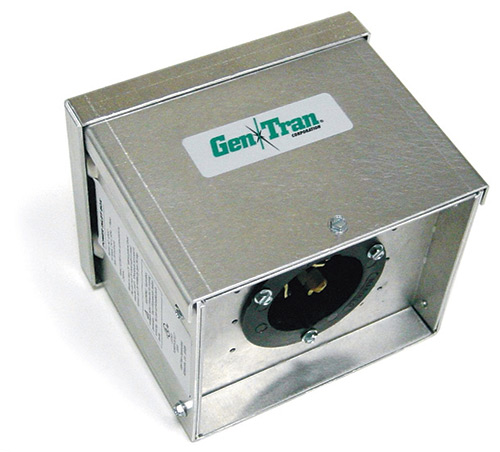Connecting your generator to your home
When considering the purchase of a generator for home back up use, you should also think about installing a transfer switch device. A professionally installed transfer switch makes using your generator easy and safe.
What is a transfer switch?
A transfer switch is an electrical device that is installed next to your electrical panel in your home. It connects to the circuits in your electrical panel that you wish to power during an electrical outage.
This allows you to power these circuits by connecting the generator to the transfer switch, instead of having to run extension cords to various items.

Why do I need a transfer switch?
-
A transfer switch is required by the National Electric Code for any connection of power to a home.
-
A transfer switch is the only safe way to directly connect the generator to your home.
A transfer switch isolates selected circuits your home from the power lines. This prevents back-feed, which occurs when power goes back down the utility lines.
Back-feed can not only damage the generator, but has the potential to cause a fire.
Even worse, back-feed could electrocute any technicians who are working on the lines - causing injury or even death.
A transfer switch eliminates the risk of back-feed. It is the only safe way to connect your generator directly to your home.
-
A transfer switch is the easiest way to power your home during an outage.
Running extension cords to and from appliances can be awkward and time consuming. A transfer switch lets you use your home's wiring system to power any appliance in your home with your generator quickly and easily.
-
Other items like a furnace or a well pump cannot be connected to a generator with an extension cord. A transfer switch is the easiest and safest way to connect these items to the generator.
A transfer switch can increase the usefulness of your generator.
A transfer switch makes power management very easy to do. You can easily turn on and off various circuits to accommodate changing power needs.
This helps you to use a smaller, less expensive generator to meet your power needs. It lets you use your generator more efficiently - with less effort on your part.
Our Universal Transfer Switch , for example, can increase the usefulness of your generator, making it behave like a model as much as 20% larger.
How does a transfer switch work?
A licensed electrician will install the transfer switch into your home and connect it with the main breaker box.
The main breaker in the transfer switch switches the power source from utility to generator. The house cannot be connected to both the generator and utility power at the same time - the main breaker transfers power from one source to the other.
This prevents the generator power from back-feeding through the utility lines, as well as preventing utility power from back-feeding into the generator.
The transfer switch also contains a number of circuits. You can instruct the electrician to assign each circuit to a different load. For example, you might want to power the furnace, well pump, refrigerator, and some lights. You can assign different circuits to power each appliance or room.
You may have more items on different circuits than the generator is capable of powering at the same time. However, using a transfer switch will make it easy to switch between different loads. Just turn one circuit off, and the other on. Our Universal Transfer Switch will even do this for you. A transfer switch makes it easy to manage your power usage and maximize your generator's effectiveness.

What options are available?
Honda has a wide variety of transfer switches available to meet many different needs. Talk with your dealer to help you make the right selection for your needs.
-
Manual models

These are very simple switches. You manually turn circuits on and off to manage the load on the generator and prevent overloads. Manual switches are typically less expensive because of lower installation costs.
A variety of models and styles are available, including models that can be expanded up to 16 circuits.
-
Automatic (Universal) Transfer Switch

The UTS, or Universal Transfer Switch, automatically handles many of your power needs during an outage. The UTS is highly programmable. You can determine which items have the highest priority.
It will automatically adjust the generator's power flow as necessary to prevent overloading the generator. There is no need to manually toggle circuits or switches. The UTS makes power management easy - increasing how many items you can power with your generator.
The UTS also monitors the status of your utility power. When power is restored, it automatically reconnects your home to utility source and disconnects it from the generator. The UTS is also configured to use with a UPS (Uninterruptible Power Source), a battery backup. A UPS can provide temporary back up power for immediate needs before starting your generator.
For example, you might use the UPS to power your garage door, a few lights, or your computer to check the weather forecast. Additional information about the UTS
Additional information about the UTS
-
Inlet Box
For many generator applications, you'll want to install an inlet box on the outside of your home.
How do I use a transfer switch?
-
Manual Switches:
Your owner's manual will have detailed instructions on using your transfer switch properly. Be sure to review it thoroughly before use.
When the utility power goes out:
- Connect the generator cord to the transfer switch or inlet box.
- Turn off all the circuit breakers in the transfer switch to the off position.
- Start the generator and let it warm up.
- Flip the main breakers in the transfer switch to the Generator position.
- Turn on the circuits you wish to power, one at a time. This will help to prevent the generator from being overloaded.
- Turn the main breakers in the transfer switch back to Utility Power.
- Turn on any other circuits that were turned off.
- Turn off the generator.
- Disconnect any cords.
-
UTS:
Simply start your generator and connect it to the transfer switch. The UTS will automatically detect power and adjust the circuits as necessary. When power is restored, disconnect your generator and turn it off.
Be sure to review your owner's manual thoroughly before use.
When the power is restored:








